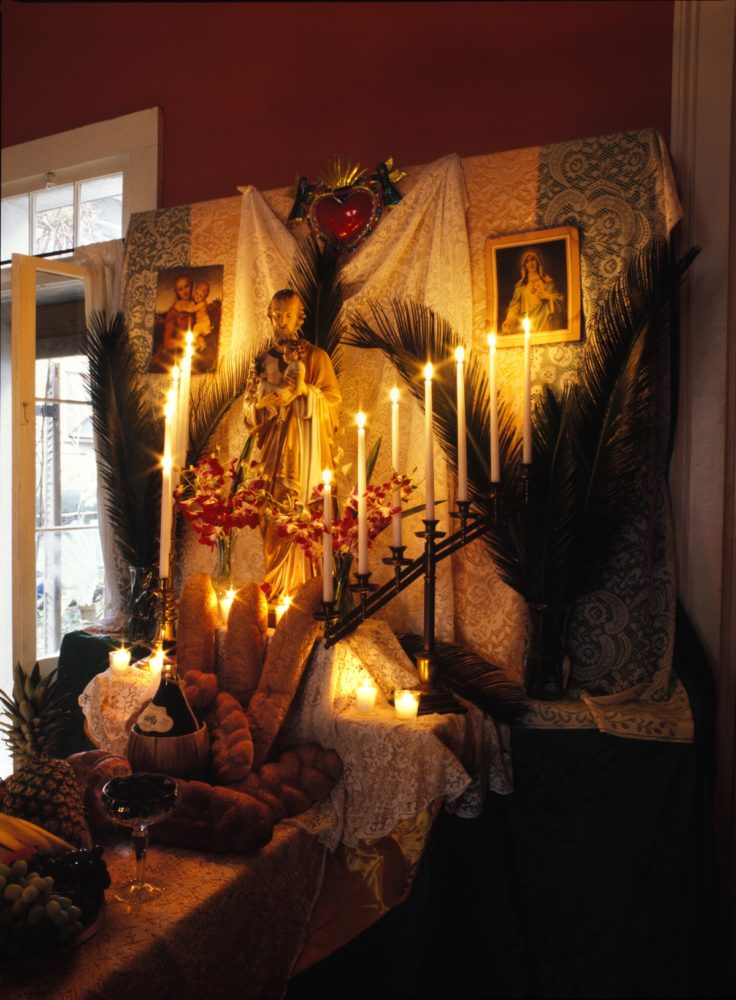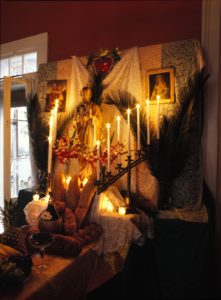St. Joseph’s Day
The Sicilian roots of a local feast
Published: March 1, 2020
Last Updated: June 1, 2023

Photo by Kerri McCaffety from her book "St. Joseph Altars", Pelican Publishing
A St. Joseph’s altar in the parlor of Tony Marino’s French Quarter home.
In the 1500s Sicily was beleaguered by a drought. As crops failed and families began to starve, the people beseeched Saint Joseph for rain. They promised that if their prayers were answered they would lavish Saint Joseph with a feast. When the rains came, a new tradition was born and the people of Sicily would continue to honor their promise to Saint Joseph. When the Louisiana Bureau of Immigration began campaigning to recruit workers to the sugar cane fields in 1866, thousands of Sicilians emigrated to New Orleans. These new arrivals and their descendants did not forget the saint that had been there for them, and the tradition of the feast of Saint Joseph continues to this day.
Although there is no prescribed way to construct an altar—they can be as lavish or humble as you wish—if you visit enough of them, you will begin to see certain recurring features. A green branch hung over a doorway announces that a home has constructed an altar and the public is welcome to view it. The altar itself is traditionally arranged in a three-tiered structure meant to evoke the Holy Trinity—and some choose to honor Saint Joseph by doing the woodworking themselves. Festooning the display with red, white, and green—the colors of Italy—is a popular choice. A basket of hand-written petitions is collected so that the creator of the altar may pray over them in the year to come. But of course, the real star of any feast is the food.
On the altar you might find hand tools like saws and hammers artfully wrought out of bread. Often you will see pignolata, a pastry made out of fried dough that has been glued together with honey and shaped to resemble the pinecones Jesus was thought to have played with as a child. Brightly colored eggs poke out of pupaculova, a basket-shaped bread reminding the faithful that Easter is coming. Even the sawdust from Saint Joseph’s workshop makes an appearance in the form of mudrica, a blend ofbreadcrumbs, sugar and cinnamon that gets sprinkled atop the pasta milanese.
On the way out the door, visitors to an altar can typically expect to receive a bag of cookies (the fig stuffed cuccidati or the sesame-flecked biscotti regina) as well as a few items of devotion. Along with a prayer card or a small plastic statue of Saint Joseph, these bags almost always contain a bit of blessed bread and a fava bean, both of which should be kept in the home throughout the year. The blessed bread is to be kept until a storm threatens—at which point you should say a prayer to Saint Joseph and toss the bread out of the window for protection. The fava bean—thought to be the first crop grown after the famine that blighted Sicily—should be kept in either your wallet or pantry. Wherever you place the bean will not be empty for the rest of the year.
Anyone can be a part of the celebration, regardless of religious affiliation. Saint Joseph’s Day allows the city to join together to reflect on the blessings of the past year, to welcome others into their devotion, and perhaps most importantly, to share a meal.
Gregory Theriot has never been caught without a fava bean.
